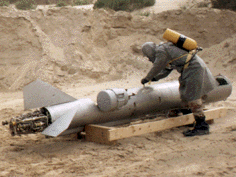Ch-28
| Ch-28 | |
|---|---|
| General Information | |
| Type | Air-to-surface missile |
| Local name | Ch-28 |
| NATO designation | AS-9 Kyle |
| Country of origin |
|
| Manufacturer | Raduga design office |
| development | 1963 |
| Commissioning | 1973 |
| Working time | 1973-1997 |
| Technical specifications | |
| length | 6.04 m |
| diameter | 430 mm |
| Combat weight | 715 kg |
| span | 1,930 mm |
| drive | Liquid fuel rocket engine |
| speed | Mach 2.4-3.0 |
| Range | 80-120 km |
| Furnishing | |
| steering | INS |
| Target location | passive radar seeker |
| Warhead | 140 kg fragmentation warhead |
| Detonator | Proximity fuse |
| Weapon platforms | Planes |
| Lists on the subject | |
The Ch-28 ( Russian Х-28 , NATO code name AS-9 Kyle ) was a Soviet air-to-surface missile . It served to combat ground-based radar systems.
development
Based on the US experience in the Vietnam War , the development of an anti-radar missile was planned in the Soviet Union in the early 1960s. The order was awarded to OKB-155-2 (later the Raduga design office ). Development began in 1963. The planned guided missile was to be used with the Jakowlew Jak-28 . At first it was planned to equip the Ch-28 with a solid rocket engine . However, due to the required range of 120 km, this could not be achieved with the resources available at the time. Therefore, a rocket motor with liquid fuel was used. After a development period of ten years, the Ch-28 was introduced by the Soviet Air Force in 1973 . The Ch-28 was the Soviet counterpart to the US AGM-78 .
technology
The Ch-28 is basically a smaller version of the Ch-22 . It was propelled by the liquid fuel twin -chamber engine R-253-300 . This developed a thrust of 8 kN . It used to fuel TG-02 and AK-27 - oxidizer . The rocket had to be refueled with the toxic liquids immediately before it was deployed on the base . The Ch-28 was used to hold down enemy air defenses . Your seeker switched to the frequency of the enemy radar and uses this to hit the radar position. For this purpose, the CH-28 used the APR-28 seeker head. This had interchangeable modules which were tuned to the frequency bands of the anti-aircraft missiles Nike Hercules , Thunderbird, Bloodhound and later also Hawk .
To record the radar radiation, the emergency aircraft had to be equipped with a special radar receiver. In the case of the Sukhoi Su-24 , this was the Filin-H system integrated in the aircraft . The Metel gondola, which was carried externally, was used for the Suchoi Su-17 . If the radar receiver had received radar radiation, the aircraft had to fly a serpentine course at a constant altitude for a certain time. The April 28 navigation system of the Ch-28 was able to determine the position of the radar system using trigonometric calculations. Then the missile could be launched from an altitude range of 200–15,000 m. From a starting altitude of 5,000 m, it had an operational range of 70 km. For a start under 1,000 m, this value was 45 km. After the drop, there was a short period of non-propulsion. The rocket engine only ignited at a safe distance from the aircraft. The Ch-28 was now flying towards the radar system with the help of the seeker head and the autopilot. If the radar system stopped transmitting during this time, the Ch-28 could maintain the course it had taken for a maximum of 10 seconds ; after that she lost the target. The warhead was detonated using a proximity fuse . In the optimal case, this was done around 5 m above the radar system. The hit expectation was around 80% and the scattering circle radius ( CEP ) was around 20 m. The 9A283 fragmentation warhead weighed 140 kg and contained 74 kg of explosives .
variants
- Ch-28: standard version, introduced in 1973
- Ch-28M: Version with improved PRG-28M seeker head, introduced in 1977
- Ch-28E: export version
Platforms
- Jakowlew Jak-28 (NATO code name: Brewer)
- Sukhoi Su-17 (Fitter)
- Sukhoi Su-22 (Fitter)
- Sukhoi Su-24 (Fencer)
distribution
-
 Afghanistan
Afghanistan
-
 Azerbaijan
Azerbaijan
-
 Georgia
Georgia
-
 India
India
-
 Iraq
Iraq
-
 Kazakhstan
Kazakhstan
-
 Libya
Libya
-
 Poland
Poland
-
 Syria
Syria
-
 Soviet Union
Soviet Union
-
 Ukraine
Ukraine
-
 Hungary
Hungary
-
 Vietnam
Vietnam
-
 Belarus
Belarus
Individual evidence
- ↑ a b rbase.new-factoria.ru , accessed on February 18, 2014
- ↑ a b c airwar.ru , accessed on February 18, 2014
- ↑ a b The AS-9 air-to-ground guided missile system Kyle DTIG - Defense Threat Informations Group, January 1997
- ^ A b Phillip E. Pace: Detecting and Classifying Low Probability of Intercept Radar. Artech House Publishers, 2003, p. 582.
- ↑ a b Michal Fiszer: Crimson SEAD. Journal of Electronic Defense (JED), January 2003.
- ↑ a b c militaryrussia.ru , accessed on February 18, 2014
- ^ Trade Register at sipri.org , accessed on February 18, 2014
